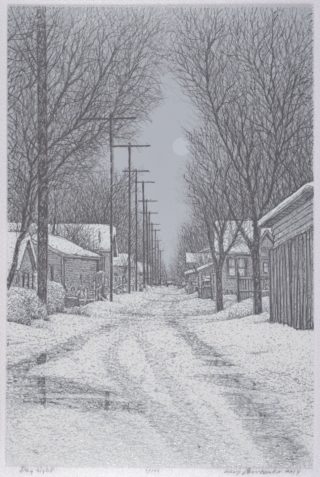Snowy Lane
An Austrian Philosopher walked along a laneway between Victorian mansions on one side and on the other side backyard cabbage gardens of the working poor. The philosopher’s specialty was not political theory. To him the scene was neutral. The simple lane was straight and it was narrow. He always felt comforted by dusk, when indistinct colours become shadows and street lamps are like cats’ eyes. It was pleasant to perceive this quiet lane as an illustration of his state of mind.
The philosopher was contemplating symbolization. For this he decided to observe the back alley as an ordinary place devoid of theatrical moments, a place neither of movements nor of sound. Beneath a fresh but unimpressive snowfall the roofs were unified visually by their toppings of flat white snow. The philosopher felt he could accept this visual motif, but otherwise he insisted to himself that the laneway was “blank.” Toying with the vernacular the philosopher described the scene to himself as “empty,” a word that betrayed a conceptual difficulty the philosopher was confronting
The philosopher hoped that he was walking where the pure idea of symbol would not be disturbed. For quite some time he had been considering the idea of symbol as simply that, pure idea. He wanted to eliminate if he could the certainty that symbol as pure idea is oxymoronic; he wanted to propose a symbol of nothing, not a symbol in the sense that words and numbers symbolize. “Nothing,” “void,” “vacant” were commonplaces and vernacular, insufficient for philosophic inquiry. Zero is after all a word when it isn’t arithmetical.
In this nondescript alley it seemed there would be no object so unusual as to have a symbolic effect. The alley was quintessentially austere. The philosopher wanted his thoughts to be quintessentially austere. In such a place the contradiction he was trying to dissolve could yield to innovative reasoning. The philosopher did expect an interruption by a crow plunging into view, but he would deny that every single crow is by definition symbolic.
The philosopher was cogitating the possible existence of a symbol for nothing, a symbol of nothing. The philosopher was conducting a mind experiment in which a visual symbol of nothing was attainable, beyond reduction to a practical word like “vacuum” or “abyss.” The contradiction was whether a recognizable something, a single visual something could always and instantly evoke the idea of nothing.
La Betty, unfettered by abstractions, slept through most of this particular dream. Until the very end of this dream it had appeared to be only a scene of an ordinary man walking down an ordinary laneway. After all, the quiet little philosopher’s thought was invisible.
This philosopher was, however, a ruse. La Betty’s dream was being invaded by an entity in the guise of a philosopher. The entity in disguise as an abstract thinker was using stillness to lull La Betty away from her lifestyle. Numerous strategies had already failed, but there was always another miscreant with another appalling idea. This entity’s challenge was to manipulate La Betty into mistaking her blunt superficiality for abstract thought.
The appeal of abstract thought can be its self-referential logic. Numbers are the starkest example of this, the way numbers procreate, subtract each other, pile up and on many occasions disengage themselves from common sense, measuring, tracking and predicting events about other numbers. The faux-philosopher of course was not planning to explain this to La Betty. This entity’s bold strategy was to sneak abstraction in where La Betty’s utterly shallow attitude prevailed, to insert abstraction where La Betty had established superficiality (In a sense La Betty’s superficiality and her dedication to image have a self-referential logic.). The philosopher-fiend had taken on the challenge of swooping La Betty into the world of ideas, propositions and dialectical reasoning.
La Betty began experiencing the philosopher-phantasm’s solemnity as if it was a cloud of gnats. She woke herself up with her own slapping and flailing. La Betty immediately recognized the invasion of the dream for what it was. To assume that pure surface-adoration could be replaced by unadorned abstract thinking couldn’t have been sillier. La Betty looked around her sitting room, at the bare Tiffany blue walls, the Swarovski transparent crystal chandelier, the porcelain sculpture of Michael Jackson with a chimpanzee, and beneath it the Iranian Kashkoli Gabbeh rug, the green lacquered surface of the vacant walk-in closet. The look of all these deluxe objects soothed La Betty. She sighed and she luxuriated in ownership.
Wilf Perrault
Canadian, born 1947
Day Light, 2014
screenprint on lexan, edition 1/100
30.4 x 20.2 cm
Collection of the MacKenzie Art Gallery
2015-3
